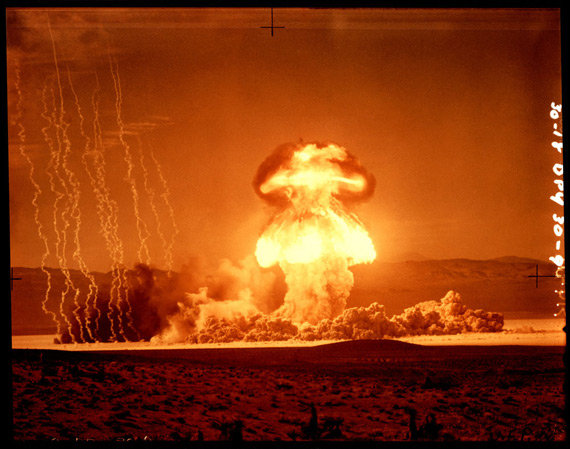Michael Light
dal 4/11/2009 al 30/12/2009
Segnalato da
4/11/2009
Michael Light
Foundation Yours Gallery, Warsaw
100 Suns. The images in this exhibition show U.S. atomic detonations from the era of above-ground nuclear testing, which lasted from July 16, 1945 to November 4, 1962. In that time, the United States conducted 216 nuclear tests in the atmosphere and oceans, and the Soviet Union conducted 217. The photographs depict the tests at or near the moment of detonation, and most were declassified by the U.S. government shortly after test completion.

The images in this exhibition show U.S. atomic detonations from the era of above-ground nuclear testing, which lasted from July 16, 1945 to November 4, 1962. In that time, the United States conducted 216 nuclear tests in the atmosphere and oceans, and the Soviet Union conducted 217. After both countries signed the Limited Test Ban Treaty on August 5, 1963, nuclear testing in the atmosphere, the oceans, and cosmic space ceased. Thereafter, both nations vigorously pursued nuclear testing underground. The United States would go on to perform a total of 1054 nuclear tests, involving 1148 separate explosions, until its last test occurred on September 23, 1992. The Soviet Union would conduct a total of 715 tests, involving 969 separate explosions, until its last test event on October 24, 1990. That nation would formally dissolve 13 months later.
Since their inception, nuclear weapons have been used twice in combat. On August 6, 1945, the United States dropped a bomb with a yield of 15 kilotons - the destructive force of 15,000 tons of TNT - on the Japanese city of Hiroshima, eventually killing over 200,000 people. Three days later the United States destroyed the Japanese city of Nagasaki with a bomb yielding 21 kilotons; over 60,000 people would eventually die. Japan agreed to unconditional surrender five days later, and World War II ended shortly thereafter.
Of the 216 atmospheric tests detonated by the United States, 106 of them occurred continentally at the Nevada Test Site, 63 miles from Las Vegas. The footprint of harmful radioactive fallout from those detonations flowed generally to the east and northeast of the test site, often extending the length of the nation and occasionally into the Atlantic Ocean beyond. Those areas immediately east and north of the test site in Nevada and Utah were hardest hit throughout the 1950s and early 1960s, though the U.S. government attempted to minimize public perception of the danger through a systematic campaign of propaganda and intimidation.
The Lookout Mountain cameramen generated vast amounts of visual documentation of each test, bringing their manned cameras as close as 4 miles to the point of detonation in Nevada and operating remotely-controlled ones closer. During the much larger Pacific tests, they kept their manned cameras a minimum of 20 miles from the blast point. Only a small fraction of the extensive documentation of nuclear tests by Lookout Mountain and the Army Signal Corps can now be found in publicly-accessible U.S. government archives. One cannot help but wonder what as citizens we still do not know about the subject of nuclear weapons, not only in the sense of the surreal excesses of the cold war past, but in terms of the hidden, weaponized nuclear present that will be with us for as long as we know time.
While eliminating the global specter of radioactive fallout and perhaps somewhat moderating the nuclear saber-rattling of nations, the shift to exclusively underground testing brought about by the 1963 Limited Test Ban Treaty came at a paradoxically high price: cultural invisibility and secrecy. The United States has detonated four times as many nuclear detonations underground as it has above. In all of these underground tests, there has been little to see and little to photograph.
Each of the 1148 U.S. nuclear test detonations was given a code-name by either the U.S. military or the Atomic Energy Commission. Names were initially based on the military phonetic alphabet (Able, Baker, Charlie, and so forth), but quickly branched out into more arbitrary and eclectic nomenclature to avoid duplication and confusion. Test names were never indicative of the nature of the actual classified nuclear device or weapon at hand.
The photographs in 100 SUNS depict U.S. nuclear tests at or near the moment of detonation, and most were declassified by the U.S. government shortly after test completion. The United States usually announced atmospheric tests in advance, and images that did not reveal the size, shape, weight or inner workings of a nuclear device were released to the public, often to underscore to domestic and international audiences the power or innovation of a particular test. Most of the images seen here were obtained from prints at the U.S. National Archives, with a few gleaned from the records of the Los Alamos National Laboratory. The artist either re-photographed or scanned images onsite in the archives, and later printed them in varying sizes for this exhibition. In no case has any image been radically altered from the original archive print.
- Michael Light
Meeting with Michael Light on 6th November at 7pm at the Skwer -
the Branch of Artistic Centre Fabryka Trzciny, Krakowskie Przedmiescie 60A
Image: 100 Suns, Grable 15 kilotons, Nevada, 1953
Opening night will be held on 5th November 2009 at 7pm
Foundation Yours Galler
Krakowskie Przedmiescie 33, 00-071 Warsaw Poland
Hours: 11am - 8pm daily



